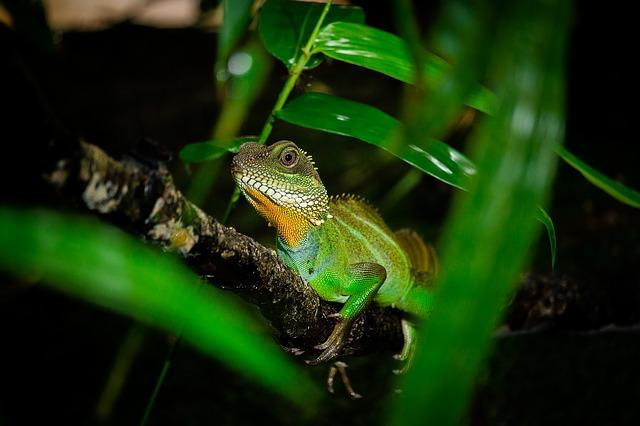
Feeding your pet reptile or amphibian a proper balanced diet is important for maintaining their health. Another important part of feeding and metabolism is proper lighting, usually accomplished with an ultraviolet B (or "UVB") bulb if housed inside, or natural unfiltered sunlight if housed outdoors.
Diet
Reptiles fall into many categories when it comes to diet. There are 3 categories: carnivore (animal eater), omnivore (mixed animal and plant eater), and herbivore (plant eater). All snakes are carnivores; some require to be fed rodents, while small species will be happy eating worms or insects. Lizards, turtles and tortoises can fall anywhere on the spectrum; some are full carnivores, others full herbivores, with many falling in the omnivore category. Amphibians such as frogs and toads are carnivores as adults, eating insects and occasionally small vertebrates. However, as tadpoles they are herbivores eating algae and decaying matter. Newts and salamanders are usually carnivores, eating insects, though some species will eat a balanced diet of pellets. It is important to know the species and life stage of your pet, and their nutritional requirements.
Feeding carnivores, such as monitor lizards or snakes, is relatively easy. Feeding them whole, frozen and then completely thawed rodents are fully balanced. Feeding insectivores and herbivores can be more challenging as their diets are not complete and require supplementation with calcium and other vitamins. When feeding insect-eating reptiles and amphibians it is important the insects (usually the common house cricket), be gut-loaded and supplemented. "Gut loading" is the process of feeding the cricket or other insect a diet that is well balanced for the reptile or amphibian that is going to in turn eat the cricket. "Gut load" can be purchased from your local pet store. It is also important the cricket or other insect be supplemented; this is usually done by "dusting" the cricket in a reptile/amphibian calcium and/or vitamin supplement. The amount of supplementation and the kind of supplement will vary by species. Likewise, feeding herbivores usually requires supplementation; this is usually done by dusting the vegetable matter with a calcium or vitamin supplement. Again, the type and frequency of supplementation will vary by species.
Other species, like water turtles, will have a formulated pellet make up the majority of their diet. For these species, it is important to know how much of the diet should be made up of pellets and how much should be made up of fresh vegetables like dark leafy greens, peppers or fruit; verse, animal protein like insects, fish or frozen then fully thawed mice.
Lighting
Many problems arise from improper lighting. Heat bulbs may be provided to add heat to enclosures, and ultraviolet B ("UVB") lighting can facilitate metabolizing of calcium and vitamin D. UVB is a wavelength of light that is very important for proper bone development in reptiles and amphibians. It is very important for most reptiles and amphibians to have access to proper UVB lighting. These bulbs should be changed every 6 months, even if they are still emitting visible light, as they stop making UVB rays at that point. It is important to note that many snakes do not require UVB lighting as they get all their vitamin D from their diet.
Owning and caring for a reptile or amphibian can be challenging because one must meet the specialized needs of these unique animals. Many of these pets become ill because their requirements for heat, humidity, lighting, and diet are not met. In turn, successful care can be a very rewarding experience, so it is important to research the species you are looking to get, and know what is required to house, feed, and care for these amazing creatures.
